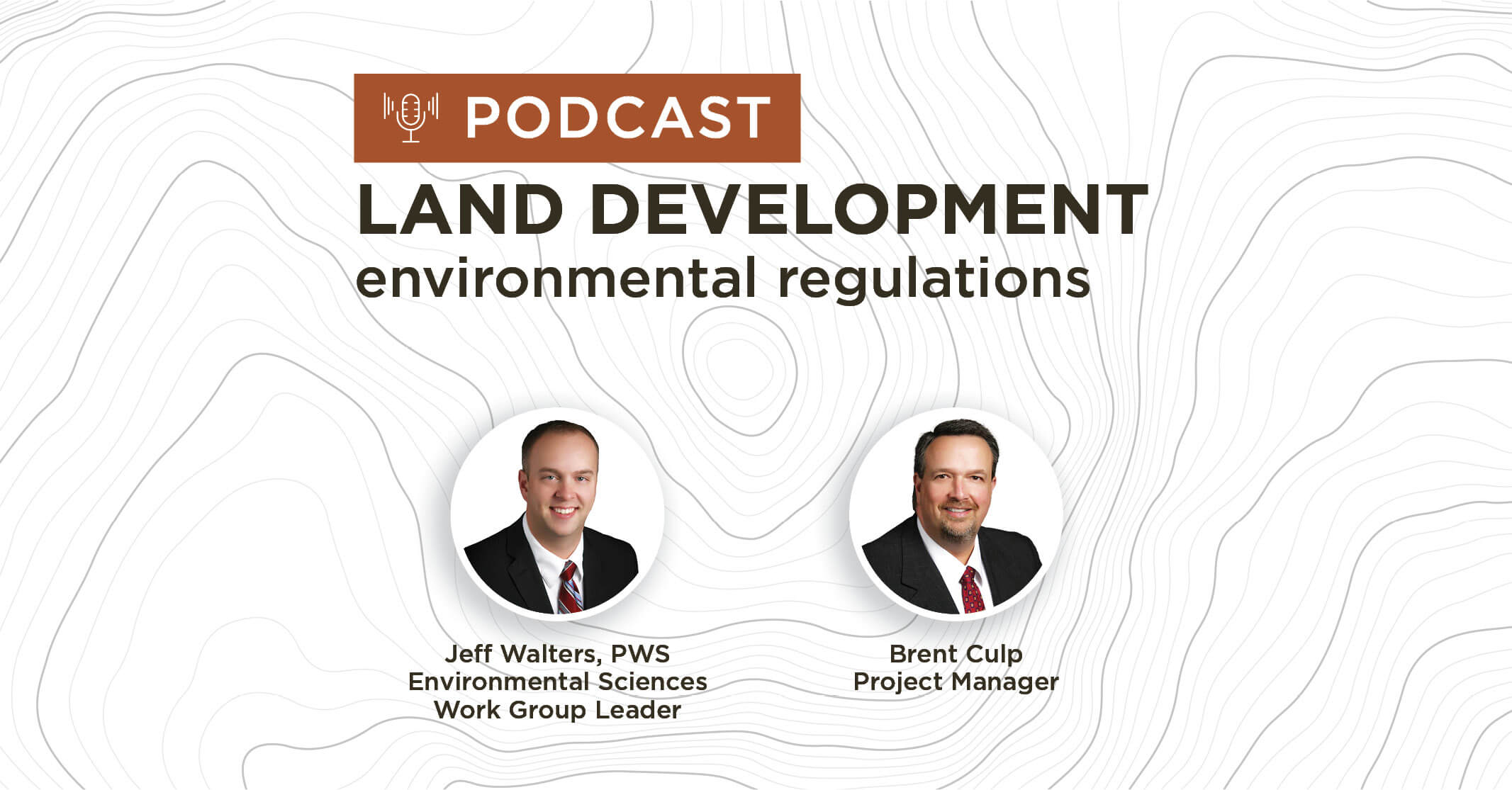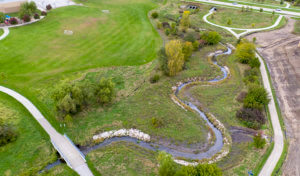Land Development Professionals Explore Regulatory Challenges
Our team of experts in land development and permitting is committed to providing timely and cost-efficient services for your site development project. We know the various stages and approvals needed to accomplish this task, and we prioritize obtaining them despite potential changes and complexities. We strive to prevent delays through early preparations and allow projects to progress smoothly. Our client’s satisfaction is our top priority, as we seek to contribute to the betterment of the community. We believe that a healthy environment is essential for a well-functioning community.
Join the conversation as Environmental Scientist Jeff Walters, PWS, welcomes Brent Culp, a site development specialist from Snyder & Associates, to explore the environmental regulations that apply to land development projects and the importance of timing throughout the process. Our team has the necessary expertise in regulations, technical skills, and project management to assist our clients in selecting effective solutions.
Podcast Agenda
- Timing of Land Development Projects (0:18)
- Challenges in Land Development Projects (3:40)
- Importance of Early Scope of Services Understanding (6:47)
- Land Development Clients are Prioritizing Environmental Responsibility (8:28)

Jeff Walters, PWS
Environmental Sciences Work Group LeaderJeff Walters, PWS
Environmental Sciences Work Group LeaderWetland & Stream Delineation & Mitigation, 404 Permitting, Natural Resources Surveys, Lake & Stream Restoration

Brent Culp
Project ManagerBrent Culp
Project ManagerMaster Planning, Industrial and Commercial Site Design, Residential Development
Land Development Project Timing
Jeff Walters (0:18)
Brent, what is your biggest sector issue pertaining to environmental regulations these days?
Brent Culp (0:24)
I’d probably likely say how it affects the timing of the project or the extended months. I wouldn’t go into years, but extended months that it could add to a project if it’s not done in the correct order or progressive order where we need to get out front and get this stuff, get the environmental issues addressed. Immediately upon a project, understand it during the scoping that if the project’s going to have any environmental issues, that’s usually, you know, when you always come into play and run by a site doing a windshield survey or see what we got, any issues, concerns that we might have on a site. Get that into the scope and then work from there on getting the tasks accomplished in a timely manner.
Jeff Walters (1:11)
You and I go back 20 years now, at least. I think one of the first projects we had was Diamond Hills here in town, and we had wetland delineation out there that was the start of our relationship, even before working at Snyder. So things really haven’t changed a whole lot in that 20 years, except I think you and I and the Development Business Unit have really coalesced, and tied together, a much better process so that we’re not always doing environmental work either in a silo or in the eleventh hour. You guys understand that if we get in early and get in often we can help reduce impacts, reduce the time that you mentioned to make sure our clients are getting their project done on time and hopefully under budget or the schedule isn’t delayed so much that it has to push them into another construction year.
Brent Culp (2:08)
Yeah, that’s correct. A lot of times it’s not just the length it takes to do an assessment. It’s the time of the year you’ve to hit, and it can’t be winter for the wetlands and stuff. I think a successful project would be the project we had an Urbandale. I don’t know if you recall that one? Where we had a storm sewer system outletting into an intermittent stream, and the owner was out there, and the EPA guy from Kansas City was out? I think he was looking to nail him on that specific item? He questioned the owner at that time, and the owner just happened to have our 404 permit available and really saved that project. That’s a project that really helped me understand the importance of what’s needed on the environmental side for every project we get involved with.
Jeff Walters (3:00)
Yeah, definitely dotting the I’s, crossing the T’s early on so the clients have that correct documentation in hand is very important for exactly that reason. You just don’t know when a regulator may come out to the site and start asking questions. And for us, it’s really about protecting that client more than anything else because if a project fails on the environmental side, we’re not doing that client any justice.
Brent Culp (3:28)
I think every year it gets more and more acceptable, as a practice, of something that’s a good idea. It’s pretty much what has to be done.
Jeff Walters (3:40)
So what are some common environmental hurdles that you and your clients work through these days?
Land Development Project Hurdles
Brent Culp (3:45)
It’d be the wetland delineation and the stream mitigation, much like we had on the Crosswinds project here in Ankeny and how that was addressed. Bat survey, I just had a project a client made sure that was addressed prior to that March 30th. We purposely got everything handled with the City of Des Moines on that project and got that addressed. There are just all kinds of hurdles, we’re involved often, but nothing quite like you guys are constantly having your hands in understanding the current rules or regulations or requirements that are it seems like ever-changing.
Jeff Walters (4:24)
You mentioned streams and stream delineations, and that’s really become a hot topic here in recent years with the U.S. Army Corps of Engineers (Corps of Engineers) and the Department of Natural Resources, where we have stream mitigation available for stream impacts. Hopefully, that’s helping our clients instead of the days of reconstructing meandered streams to get credit. We can now purchase credit at these banks and make that process a lot more streamlined for our clients. Especially the developers who are usually crossing a stream via a new roadway, or maybe they’re putting new storm sewer outlets into a stream, and that has an impact that requires permitting, and you get enough of those impacts, and it has some level of mitigation. And then you mentioned bat habitat surveys and making sure we get those habitat surveys done in a timely manner, so that our no-cut dates are enforced. Conversely, the contractors for the developers can get out and cut those trees down within those windows, so the developer can start grading in the springtime instead of waiting a whole construction season to get moving because there’s potential bat habitat still at the project sites.
Brent Culp (5:41)
One thing that was interesting on that project is the developer was familiar enough, which five to 10 years ago, most developers wouldn’t hear of the requirements that are associated with it. And actually, he mentioned it in the meeting and brought up that he wanted to make sure he was within the window and it’s available to do that.
Jeff Walters (6:02)
The bat issues have been around for 15 years now, right around there. And they’ve really ramped up here in the past few years, primarily because the EPA and Iowa Department of Natural Resources have really streamlined the rules. But you know, some of our other clients are municipal clients such as Iowa DOT, and certain cities and counties have also changed their ordinance and recognize that this is not just a one-time thing, that it really is a federal issue. And so developers recognize that the municipalities and the DOT and those types of entities are now requiring those types of studies to be done prior to issuing the grading permit.
Importance of Early Scope of Services Understanding
Jeff Walters (6:47)
So as the Environmental Business Unit here at Snyder, how can we support your clients and projects?
Brent Culp (6:55)
Early on, understanding and allowing us to establish the scope of services that we’re able to present. With the estimated fee on what it would be to accomplish these tasks. Then once we are received the notice to proceed, getting out there and just getting the work done and helping the client understand that there are certain times of the years you can’t do wetland delineation and there’s a specific schedule this required and a list of requirements to accomplish your tasks.
Jeff Walters (7:28)
Yeah. Sometimes we forget that these developers are getting permissions from cities or counties and the cities and counties have a schedule to abide by as well. If we’re not getting in there early and often to complete these environmental documentation and field visits, we hinder the scheduling process with the developers. So if they miss a submittal for a city that knocks them back a couple of weeks, and a couple of weeks, and a couple of weeks, and pretty soon they’re looking at us going, what’s going on? But if we can, as you said, get in early and often, and it’s important and helps. We still have those11th-hour fire drills every once in a while, and we do everything we can to accommodate the developer to make sure that prior to them moving dirt and pushing down trees that they have the required environmental documentation that’s needed to get their project approved.
Land Development Clients are Prioritizing Environmental Responsibility
Jeff Walters (8:28)
What are some foreseeable changes that you anticipate with your clients as we move forward?
Brent Culp (8:33)
I would think just the clients, most of my clients aren’t the good old boys anymore. Most of them are national firms and out-of-state firms. Surprisingly a lot of them are from Minnesota, where it seems like the environmental aspects of projects are a decade ahead of what we’ve experienced in the past. They really understand the importance of environmental requirements, even if it’s not something important to a local jurisdiction. We’re dealing with national requirements, national laws that they have to abide by, and they’re unwilling to cut corners. They want to do it right. We just helped another firm out of Kansas City that was their number one concern, to get out on site, get the wetlands delineated, and have an understanding of what they’re dealing with, right up front so they can actually come in and work on a concept plan that takes into consideration the environmental aspects of that particular project or their parcel.
Jeff Walters (9:38)
Yeah, I’ve noticed that too. Our newer clients and especially some of those bigger clients are far more sophisticated than some of our clients in years past, which is great because the level of education required to get them up to speed isn’t there anymore. They know and we know how to track that project and get the work done to keep their project on schedule. But I’ve also noticed that some of our local clients, some of the smaller developer clients are still very sophisticated and every once in a while it seems to be, less and less, that the education isn’t needed to as great a detail as it used to be. And you know, that’s great. We’re still more than willing to come in and sit down with your clients walk through the process so that they understand. Here’s why we’re doing it. It’s not because we are looking for scope creep or additional services. We want to make sure that your project moves forward, you’re well within the realm of the law, and you’re not breaking the law. I think that’s what’s really most important to us in our Environmental Business Unit is to make sure we keep our clients safe.
Brent Culp (10:53)
I think lately with the current administration, there’s been a lot of changes and they really don’t understand. Do I not have to do this anymore? Can I work with this or that? It is trying to interpret the current administration’s changes or modifications to the Clean Water Act, EPA requirements, which you have helped with current projects.
Jeff Walters (11:30)
Yeah. And that’s something we keep up on constantly. We’re always reviewing proposed, and current law, newly issued law, especially as pertains is to acts like the Clean Water Act, Endangered Species Act (ESA), and Clean Air Act (CAA). Those change every couple of years and they change with administration at the federal level. And some of our state laws change every few years, to a lesser extent. So making sure that we’re current and understand those laws, and have the relationships with the regulators like the Corps of Engineers, Iowa Department of Natural Resources, EPA, U.S. Fish and Wildlife Service, and others. Having those great relationships with those entities really helps us to help you and your client move the project along. If a potential project is in jeopardy because of a rule, we can explain here’s how we get through it. Here’s the route to get through it with the least amount of impact to your project and ultimately get you across the finish line as quickly as possible.
Brent Culp (12:37)
Yeah, I appreciate that.
Jeff Walters (12:40)
So any other final thoughts before we leave?
Brent Culp (12:44)
Not really. We’ve got some other projects that have come in recently. We need to sit down and talk about. I’ve got one right here when we’re done here. We’ll take a look at that and continue on, I guess.
Jeff Walters (12:55)
All right, well, Brent, I appreciate your time.
Brent Culp (12:57)
Anytime. Thank you.

